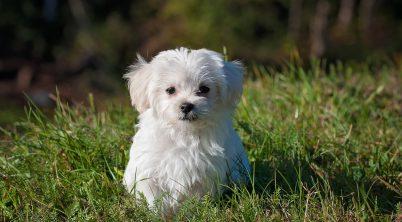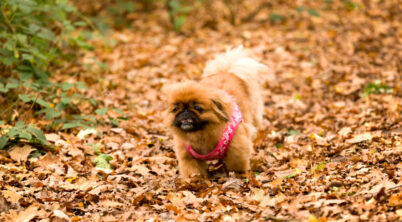Pekingese are a distinctive breed known for their lion-like mane and bold personality. While generally resilient, Pekingese can be susceptible to a range of eye problems due to their prominent ocular features. Occasionally, these issues can lead to a Pekingese having only one functional eye, either from birth defects, injury, or diseases that necessitate the surgical removal of an eye.
Having one eye can affect a Pekingese’s depth perception and spatial awareness, but dogs are remarkably adaptable and can continue to lead happy lives. Owners of such Pekingese may need to make some adjustments to their home and handling to safeguard the remaining eye while also addressing any health concerns promptly to prevent further issues.
Caring for a Pekingese with one eye involves regular veterinary check-ups to monitor eye health, taking precautions to prevent injury to the other eye, and maintaining a secure environment that is safe for a pet with limited vision. These dogs often maintain a high quality of life and can enjoy similar activities to their two-eyed counterparts, though they may require some extra patience and attention from their owners.
Table of Contents
Caring for a One-Eyed Pekingese
In managing a Pekingese with a single eye, attention to detail is imperative when it comes to grooming and nutrition to ensure health and comfort.
Grooming Needs
Regular grooming is essential for a one-eyed Pekingese to prevent any infections or complications.
- Daily Eye Care: They should have their remaining eye gently cleaned to remove any discharge or buildup, using a soft, damp cloth.
- Hair Trimming: The fur around the eye should be kept neatly trimmed to avoid irritation. It’s advisable to get this done by a professional groomer or carefully at home with the correct tools.
- Ear Cleaning: The ears need cleaning with a vet-recommended solution, being careful not to probe deeply which may cause harm.
- General Grooming: The Pekingese’s coat requires routine brushing to avoid matting—several times a week for long-haired breeds to maintain hygiene and comfort.
Visits to the veterinarian should include eye checkups to monitor the health of the remaining eye, and any prescribed ointments or medications should be administered as directed.
Nutrition and Diet
Nutrition plays a vital role in the health of a one-eyed Pekingese. A balanced diet supports overall well-being and immunity, which is crucial for a dog with a sensory impairment.
- High-Quality Diet: Feed them high-quality dog food that’s rich in nutrients suitable for their size, age, and activity level. This will help maintain their coat, skin, and eye health.
- Appropriate Portions: Pekingese are prone to obesity, so it’s important to measure out their food and adhere to a feeding schedule.
- Hydration: Always provide access to fresh water to keep them well-hydrated.
Monitoring their weight with regular vet checkups can prevent health issues related to obesity, which can affect their mobility and the condition of their remaining eye.
Health Concerns and Eye Conditions
The Pekingese breed, while known for their distinct appearance, exhibits a predisposition to several health and eye conditions. Understanding these issues is essential for maintaining their well-being.
Common Health Problems
Pekingese dogs often encounter a spectrum of health problems. Their compact size contributes to a genetic predisposition for various conditions. Notable health issues include:
- Respiratory Issues: Due to their brachycephalic nature, respiratory difficulties are common.
- Skin Allergies: They may experience allergic reactions leading to skin irritation and infection.
- General Discomfort: Congenital defects, obesity, and other common canine ailments can cause discomfort.
Specifics of Eye Health in Pekingese
The prominent eyes of the Pekingese breed are susceptible to multiple disorders:
- Dry Eye (Keratoconjunctivitis Sicca): A lack of tear production causing redness and discomfort.
- Cataracts: Progressive opacity in the lens may lead to blindness if untreated.
- Corneal Ulcers and Abrasions: Their bulging eyes are prone to injuries that can result in ulcers or abrasions.
Cherry Eye, characterized by a protruding third eyelid, is another common issue, manifesting as a red mass in the corner of the eye. Inflammation and infection may occur if these conditions are left unaddressed. Regular veterinary check-ups are crucial for early detection and management of these conditions, thereby ensuring the Pekingese’s eyes remain as healthy as possible.
Training and Exercise for a Pekingese
Training and exercising a Pekingese involves understanding their physical limitations and their intelligence. Consistency and creativity in training can lead to a well-adjusted pet, while adequate exercise balances their energetic and playful streaks.
Training Tips
A Pekingese puppy benefits from early socialization and consistent training. Due to their intelligence, they respond well to positive reinforcement techniques such as praise and treats. Owners should focus on basic commands at first, gradually increasing the complexity as the puppy shows progress. As they can be somewhat independent, practicing patience and utilizing short training sessions help maintain their concentration. Exercise caution when training a Pekingese with one eye; they might require additional time to adjust to commands and spatial awareness.
Key considerations for training include:
- Positive Reinforcement: Use treats and praise to encourage good behavior.
- Consistency: Establish and adhere to a regular training schedule.
- Patience: Allow time for the Pekingese to learn at their own pace.
- Adjustments for Physical Limitations: Be mindful of their one-eyed vision during training.
Exercise Requirements
The exercise regimen for a Pekingese should match their size and energy levels. They do not need extensive physical activity but do require regular, moderate exercise to remain healthy. Short walks and play sessions are sufficient for these small dogs. The Pekingese’s lifespan, typically spanning 12-15 years, can benefit from consistent, gentle exercise to prevent obesity and keep their joints mobile. Because of their potential for respiratory issues, it’s important not to overexert them, especially during hot or humid weather.
Exercise guidelines include:
- Daily Walks: Two 15-minute walks per day suffice.
- Playtime: Engage in play that stimulates their mind and body.
- Monitoring: Watch for signs of fatigue, particularly in a Pekingese with one eye.
- Weather Caution: Exercise in cool, shaded areas during hot weather to avoid overheating.
Breeding and Adoption Considerations
When seeking to bring a Pekingese into your home, especially one with special needs such as being one-eyed, potential owners must give special attention to the choice of breeder or the process of adoption. This ensures the well-being of the dog and aligns with the owner’s responsibility for its health and care.
Choosing a Breeder
When considering breeders, one should look for those who prioritize the health of the Pekingese puppies. A reputable breeder will provide detailed health records, including vaccinations and screening for common health issues associated with the breed. Prospective Pekingese owners should expect transparency and a willingness to discuss any concerns, such as the implications of adopting a one-eyed dog.
Key Factors When Selecting a Breeder:
- Health Clearances: Proof of genetic health testing and vaccinations.
- Reputation: Reviews or testimonials from previous buyers.
- Experience with breeding Pekingeses, particularly those with special needs like a missing eye.
Adopting a Rescue
Pekingese rescue groups often step in to care for abandoned or surrendered dogs. Adopting from a rescue can be a compassionate choice, and these organizations can provide extensive background on their dogs, including any health issues and personality traits. It’s crucial to discuss the special needs of a one-eyed Pekingese with the rescue to understand the care and accommodations the dog will require.
Considerations for Adopting:
- Confirm the Pekingese has received necessary vaccinations and health checks.
- Understand any potential health challenges specific to a one-eyed dog.
- Discover the Pekingese’s compatibility with your home environment and any existing pets.
When adopting or purchasing a Pekingese, one must consider their ability to provide a patient and loving environment for a dog with special requirements, such as a one-eyed Pekingese. A reputable breeder or a dedicated rescue organization can offer guidance and support to ensure the well-being of the dog.
Special Considerations for Pekingese Eye Health
Pekingese dogs exhibit distinctive facial features, with their eyes being particularly prominent. These bulging eyes can predispose them to various health issues, requiring vigilant care by the owner.
Common Symptoms:
- Squinting can indicate discomfort or a more severe condition like entropion, where the eyelid rolls inward, causing irritation.
- Redness and tearing may suggest conjunctivitis, an inflammation of the eye’s outer membrane.
- Discharge could be a sign of infection, necessitating a vet’s attention.
Preventative Care:
- Regular cleaning around the eyes to prevent the buildup of discharge.
- Ensuring that long hair does not irritate the eyes; careful grooming is essential.
Eye Injuries and Prolapse:
- Due to their protruding eyes, Pekingese are at a higher risk for eye injuries. Immediate veterinary consultation is crucial if an injury is suspected.
- Eye prolapse is a serious condition where the eye may bulge excessively, even slipping out of the socket. This requires emergency veterinary care.
Dry Eye Syndrome:
- Pekingese may suffer from keratoconjunctivitis sicca, commonly known as dry eye. Symptoms include dryness and scratching at the eyes.
- Treatment often involves artificial tears and potentially antibiotics if an infection is diagnosed.
Health Monitoring:
- Watch for excessive rubbing or sneezing, as they may indicate an underlying issue.
- Regular veterinary checkups will help ensure that any Pekingese eye problems are identified and treated promptly.
Owners must remain observant to the signs of eye health problems in Pekingese and seek veterinary care when needed, keeping their small companions healthy and comfortable.
* Banner photo by Wendy Berry, cropped | Some rights reserved








